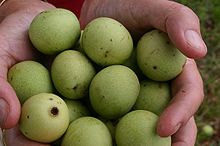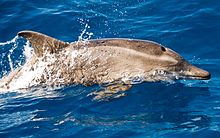Recreational drug use in animals
Several non-human animal species are said to engage in apparent recreational drug use, that is, the intentional ingestion of psychoactive substances in their environment for pleasure, though claims of such behavior in the wild are often controversial.[1] This is distinct from zoopharmacognosy, in which animals ingest or topically apply non-food substances for their health benefits, as a form of self-medication.
Alcohol
[edit]Vervet monkeys
[edit]
Some vervet monkeys in the Caribbean, particularly teenaged individuals, exhibit a preference for alcoholic beverages over non-alcoholic ones, a taste which likely developed due to the availability of fermented sugar cane juice from local plantations.[2] On Saint Kitts, these monkeys often raid bars and tourist beaches for alcoholic drinks, and become visibly inebriated. The proportions of the monkey population that do not drink, that drink in moderation, and that drink to excess mirror those proportions in humans.[3]
Myths
[edit]Elephants
[edit]
South African legends, recorded as early as the 1830s by naturalist Adulphe Delegorgue, describe elephants seeking out the fermented fruit of the marula tree, and showing signs of intoxication, including increased aggression, after doing so. This behavior was controversially depicted in the 1974 documentary Animals Are Beautiful People: the crew of the film reportedly staged the scene, either by soaking the fruit in alcohol before allowing animals to eat it,[4] or by simply injecting the animals with a veterinary anesthetic to elicit symptoms of intoxication.[5] Studies have concluded that this is a myth.[6][1] One of the studies instead attributed their aggression to the value of the trees as a food source.[2] Yet it may be possible that another intoxicant is at play – elephants are also known to eat the bark of the tree, which often contains toxic beetle pupae.[2]
Other intoxicants
[edit]Bees
[edit]A 2010 study from the University of Haifa reported that bees prefer nectar containing nicotine and caffeine over that without, and suggested that this preference may be part of the reward system driving the mutualistic feeding behavior.[7]
Cats
[edit]
About 70% of domestic cats are attracted to, and affected by, the plant Nepeta cataria, also known as catnip. The plant also affects some wild cats, including tigers, though the percentage of these cats affected is unknown. Cats sniff, lick, and sometimes chew the plant, and may rub against it, with their cheeks and whole body, by rolling over it. If cats consume concentrated extract of the plant, they quickly show signs of overexcitement, including violent twitching, profuse salivation, and sexual arousal. The reaction is caused by volatile terpenoids called nepetalactones present in the plant. Although these are mildly toxic and repel insects from the plant, their concentration is too low to poison cats.[8]: 61–63
Dolphins
[edit]
In 1995, the marine biologist Lisa Steiner reported that a group of rough-toothed dolphins near the Azores were pushing around inflated puffer fish and behaving lethargically. Puffer fish defensively excrete tetrodotoxin, which might have been having an intoxicating effect on the dolphins.[2] This behavior was also reported in the 2014 BBC documentary Dolphins - Spy in the Pod.[9][10] However, tetrodotoxin is not known to be psychoactive, and only produces numbness, tingling, and lightheadedness in small doses, while in larger doses it is extremely toxic.[2][9] For these reasons, marine biologist Christie Wilcox has expressed doubt that dolphins dose themselves with the toxin intentionally.[2]
Lemurs
[edit]Black lemurs have been documented gently biting toxic millipedes, which causes them to salivate, and then rubbing their saliva and the millipede secretions on their fur. The millipede toxins, including cyanide and benzoquinone, are thought to act primarily as an insect repellent, protecting the lemurs from diseases such as malaria, thus making this behavior a form of zoopharmacognosy. However, the toxins also appear to have a narcotic effect on the lemurs, causing them to enter an apparently blissful state, which may serve as a reward for the behavior.[11][12]
Wallabies
[edit]In Tasmania, wallabies have been reported repeatedly entering commercial poppy fields, consuming the plants, and showing signs of intoxication.[13]
See also
[edit]Further reading
[edit]- Siegel, Ronald K. Intoxication: The Universal Drive for Mind-Altering Substances. On Google Books. Inner Traditions – Bear & Company, 2005. ISBN 978-1-59477-069-2.[8]
References
[edit]- ^ a b Morris, Steve; Humphreys, David; Reynolds, Dan (April 2006). "Myth, Marula, and Elephant: An Assessment of Voluntary Ethanol Intoxication of the African Elephant (Loxodonta africana) Following Feeding on the Fruit of the Marula Tree (Sclerocarya birrea)". Physiological and Biochemical Zoology. 79 (2): 363–369. doi:10.1086/499983. PMID 16555195. S2CID 36629801. Archived from the original on March 22, 2023. Retrieved March 22, 2023.
- ^ a b c d e f Goldman, Jason G. (May 27, 2014). "Do animals like drugs and alcohol?". BBC Future. Archived from the original on March 24, 2023. Retrieved March 22, 2023.
- ^ Downer, John (April 25, 2002). "Peculiar Potions: Happy hour". Weird Nature. Series 1. Episode 4. John Downer Productions. BBC Four. Archived from the original on March 22, 2023. Retrieved March 22, 2023.
- ^ Theys, Michael (October 22, 2021). "Do African animals get drunk from marula fruit? Or is it a myth?". AfricaFreak.com. Archived from the original on April 4, 2023. Retrieved April 4, 2023.
- ^ Cooke, Lucy (April 19, 2018). "Do moose (and other animals) eat fermented fruit to get drunk?". Big Think. Archived from the original on April 4, 2023. Retrieved April 4, 2023.
- ^ Makopa, TP; Modikwe, G; Vrhovsek, U; Lotti, C; Sampaio, JP; Zhou, N (2023). "The marula and elephant intoxication myth: assessing the biodiversity of fermenting yeasts associated with marula fruits (Sclerocarya birrea)". FEMS microbes. 4: xtad018. doi:10.1093/femsmc/xtad018. PMC 10581541. PMID 37854251.
- ^ Singaravelan, Natarajan; Nee'man, Gidi; Inbar, Moshe; Izhaki, Ido (2005). "Feeding Responses of Free-flying Honeybees to Secondary Compounds Mimicking Floral Nectars". Journal of Chemical Ecology. 31 (12): 2791–2804. Bibcode:2005JCEco..31.2791S. doi:10.1007/s10886-005-8394-z. PMID 16365705. S2CID 13382917. Archived from the original on April 4, 2023. Retrieved March 23, 2023.
- ^ a b Siegel RK (2005). Intoxication: The Universal Drive for Mind-Altering Substances. Inner Traditions – Bear & Company. ISBN 978-1-59477-069-2.
- ^ a b Umer, Natasha (December 16, 2014). "9 Animals That Get Drunk Or High". BuzzFeed. Archived from the original on April 4, 2023. Retrieved March 22, 2023.
- ^ Downer, John (January 7, 2014). "Episode 2". Dolphins - Spy in the Pod. Episode 2. John Downer Productions. BBC One. Archived from the original on November 18, 2021. Retrieved March 23, 2023.
- ^ Downer, John (April 25, 2002). "Peculiar Potions: Narcotic insecticide". Weird Nature. Series 1. Episode 4. John Downer Productions. BBC Four. Archived from the original on March 22, 2023. Retrieved March 22, 2023.
- ^ Banerji, Urvija (January 29, 2016). "Lemurs Get High on Their Millipede Supply". Atlas Obscura. Archived from the original on March 24, 2023. Retrieved March 22, 2023.
- ^ "Stoned wallabies make crop circles". BBC World News. June 25, 2009. Archived from the original on March 22, 2023. Retrieved March 22, 2023.
